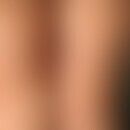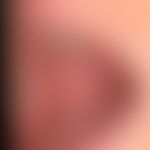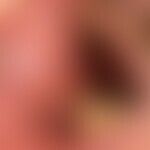Synonym(s)
HistoryThis section has been translated automatically.
DefinitionThis section has been translated automatically.
White, non-wipeable mucous membrane area that cannot be assigned to a defined disease (WHO definition). Pathogenetically, every leukoplakia, regardless of the cause, is based on an increased or abnormal keratinization of the stratified (normally non-cornnifying) squamous epithelium of the oral mucosa. The resulting change in the refraction and reflection of light leads to a white discoloration of the mucosa.
You might also be interested in
ClassificationThis section has been translated automatically.
Basically, oral leukoplakia is divided as follows:
I. Leucoplakia in the narrower sense(exogenous-irritant leukoplakia):
- Leucoplakia due to physical effects (mechanical irritation caused by damaged teeth, malposition of teeth, morsicatio buccarum).
- Leucoplakia due to chemical noxae (local contact with smoking or chewing tobacco).
- Special position: Proliferative verrucous leukoplakia
II. leukoplakia in a broader sense (see Table 1):
- Hereditary leukoplakia, e.g. nevus spongiosus albus mucosae, benign intraepithelial dyskeratosis, dyskeratosis follicularis, pachyonychia congenita and others
- Endogenous irritant leukoplakia (inflammatory or infectious): e.g. lichen planus mucosae, drug reaction, fixed, pemphigus vulgaris, glossitis interstitialis syphilitica, viral papillomas.
Starting from the clinical appearance, it is useful to further differentiate leukoplakia in the strict sense (see above) according to appearance and surface. A distinction is made between:
- Flat leukoplakia (mostly harmless)
- verrucous leukoplakia
- Erosive leukoplakia (urgent suspicion of precancerousness).
Oral erythroplakia is a precancerous special form, an analogue of erythroplasia of the genital mucosa, see below VIN and PIN.
Histologically, leukoplakia can be divided into:
- Dysplastic leukoplakia
- Non-dysplastic leukoplakia.
Occurrence/EpidemiologyThis section has been translated automatically.
Frequency (Central Europe): 0.6-3.3% of the population. Men over 40 years of age are preferentially affected, frequency 1-5%. Men are affected 3-5 times more often than women.
ManifestationThis section has been translated automatically.
LocalizationThis section has been translated automatically.
Ubiquitous in the oral cavity; preferably retro-angular, floor of the mouth, edges of the tongue, vestibulum oris, edentulous alveolar ridge.
Clinical featuresThis section has been translated automatically.
Uni- or multicentre, circumscribed or large, grey to rich white flocks with smooth or bumpy surfaces. S.a.u.
HistologyThis section has been translated automatically.
Acanthosis, hyperkeratosis (ortho- or parakeratotic). Dysplastic epithelial changes of varying degrees.
DiagnosisThis section has been translated automatically.
TherapyThis section has been translated automatically.
- Of crucial importance for the therapeutic procedure is the question of the dignity of the lesion. Histological clarification and regular control biopsies are mandatory. A leukoplakia remains suspected of malignancy until the opposite is proven. In the case of dysplastic leukoplakia a surgical procedure is necessary.
- Electrodissection of the leukoplakic area (after histological confirmation of the findings), followed by curettage of the dissected area with a sharp curette, has proven successful.
- Ablation withCO2 laser in defocused mode (diameter approx. 2-3 mm) can be attempted. The aim is ablation of the epithelium with subsequent secondary healing (healing time 6-8 weeks depending on the initial findings).
- Basically it is important to avoid causal external irritants such as defective teeth, poorly fitting dentures, smoking, alcohol, cheek chewing, UV damage (lip area), maceration in the vulva area.
Progression/forecastThis section has been translated automatically.
Risk of carcinoma. Also exogenous-irritative and endogenous-irritative leukoplakias can transform into carcinomas. The average malignancy risk of a leukoplakia is 6-17.5% and is twice as high in the group of dysplastic leukoplakia as in non-dysplastic leukoplakia. Leucoplakias at the base of the mouth and in the area of the posterior lateral edges of the tongue show a higher rate of transformation, as does erythroleukoplakia.
TablesThis section has been translated automatically.
Etiological classification of leukoplakia in the narrow and broader sense
Physical noxious agents |
Chemical noxae |
|
exogenous irritant leukoplakia |
Mechanical irritation due to damaged teeth or fillings etc. |
Leukoplakia through local contact with smoking tobacco, chewing tobacco, snuff |
Malpositioning of natural teeth (with occlusion problems) |
Leuködem (tobacco related) |
|
Morsicatio buccarum ("habitual cheek chewing") |
Leucokeratosis fumosa palati (smoker's leukokeratosis) |
|
Abrasion and pressure effect of poorly fitted dentures |
Oral submucous fibrosis (Pindborg) |
|
Scars after irradiation or burning |
Betelpriem (tobacco) leukoplakia |
|
Leukoplakia over protruding mucosal tumours (fibroids etc.) | ||
Cheilosis actinica | ||
| ||
Hereditary Leukoplakia |
White epithelial mucosal nevus ("white sponge nevus", "white folded gingivo-stomatosis", "Leukoedema exfoliativum mucosae oris", etc.) |
|
Leukedema (racial, constitutional) | ||
Benign intraepithelial dyskeratosis (Wittkop-v. Sallmann) | ||
Dyskeratosis follicularis (Darier) | ||
Dyskeratosis congenita (Zinsser-Engman-Cole) | ||
Pachyonychia congenita (Jadassohn-Lewandowsky) | ||
Epidermolysis bullosa dystrophica dominans | ||
Lipoid proteinosis (Urbach-Wiethe) | ||
Fibromatosis gingivae hereditaria | ||
| ||
endogenous irritant leukoplakia |
Chronic hyperplastic or granulomatous mycoses (candidiasis, South American and North American blastomycosis, histoplasmosis etc.) |
|
Chronic inflammatory leukoplakia of other etiology (e.g. glossitis interstitialis luica, glossitis granulomatosa in MRS) | ||
Lichen planus mucosae (partim atrophicans, partim pemphigoides) | ||
pemphigus mucosae cicatricans | ||
lichen sclerosus et atrophicus | ||
Circumscripts Scleroderma (Morphaea) | ||
lupus erythematosus | ||
pityriasis rubra pilaris | ||
Fixed drug enanthema | ||
Hypovitaminosis A | ||
Focal epithelial hyperplasia (Heck's disease) | ||
viral papilloma (atosis) | ||
Leukoplakia via granular cell neoplasm | ||
Xanthoma verruciforme | ||
LiteratureThis section has been translated automatically.
- Fisher MA (2005) Assessment of risk factors for oral leukoplakia in West Virginia. Community Dent Oral Epidemiol 33: 45-52
- Gupta PC et al (1995) Effect of cessation of tobacco use on the incidence of oral mucosal lesions in a 10-yr follow-up study of 12,212 users. Oral Dis 1: 54-58
- Haya-Fernandez MC et al (2004) The prevalence of oral leukoplakia in 138 patients with oral squamous cell carcinoma. Oral Dis 10: 346-348
- Hornstein OP (1979) Clinic, etiology and therapy of oral leukoplakia. Dermatologist 30: 40-50
- Lee CH et al (2003) The precancer risk of betel quid chewing, tobacco use and alcohol consumption in oral leukoplakia and oral submucous fibrosis in southern Taiwan. Br J Cancer 88: 366-372
- Lee JJ et al (2000) Predicting cancer development in oral leukoplakia: ten years of translational research. Clin Cancer Res 6: 1702-1710
- Lumerman H et al (1995) Oral epithelial dysplasia and the development of invasive squamous cell carcinoma. Oral Surg Oral Med Oral Pathol Oral Radiol Endod 79: 321-329
- Moreno-Lopez LA (2000) Risk of oral cancer associated with tobacco smoking, alcohol consumption and oral hygiene: a case-control study in Madrid, Spain. Oral Oncol 36: 170-174
- Munde A et al (2016) Proliferative verrucous leukoplakia: An update. J Cancer Res Ther 12:469-473.
- Murti PR (1995) Etiology of oral submucous fibrosis with special reference to the role of areca nut chewing. J Oral Catholic Med 24: 145-152
- Philipsen HP, Reichart PA (1999) Adenomatoid odontogenic tumour: facts and figures. Oral Oncol 35: 125-131
- Pindborg JJ, Reichart PA, Smith CJ, van der Waal I (1997) Histological typing of cancer and precancer of the oral mucosa. 2nd ed., Springer, Berlin
- Reibel S (2000) What safety measures need to be taken in oral food challenges in children? Allergy 5: 940-944
- Reichart PA (1997) Thai dental students' knowledge of the betel quid chewing habit in Thailand. Eur J Dent Educ 3: 126-132
- Reichart PA, Philipsen HP (1999) Oral pathology. In: Rateitschak KH, Wolf HF (eds.): Colour atlases of dentistry. Springer, Stuttgart-New York
- Scheifele C, Reichart PA (1998) Oral leukoplakia in manifest squamous epithelial carcinoma. A clinical prospective study of 101 patients. Mouth Jaw Face shield 2: 326-330
- Swimmer E (1877) The idiopathic mucous plaques of the oral cavity (Leukoplakia buccalis). Arch Dermat Syph 9: 511-570
- Sciubba JJ (2002) Brush biopsy 'bridges the gap. J Am Dent Assoc 133: 692
- Sieron A, Adamek M et al (2003) Photodynamic therapy (PDT) using topically applied delta-aminolevulinic acid (ALA) for the treatment of oral leukoplakia. J Oral Pathol Med 32: 330-336
- Sudbo J et al (2001) DNA content as a prognostic marker in patients with oral leukoplakia. N Engl J Med 344: 1270-1278
- van der Waal JE (1997) Oral leukoplakia: a clinicopathological review. Oral Oncol 33: 291-301
- van der Wal JE (1998) Parotide gland tumors: histological re-evaluation and reclassification of 478 cases. Head neck 20: 204-207
Incoming links (18)
Cornification; Glassblower callosity; Glossitis interstitialis profunda; Leuködem; Leukoplakia; Lip carcinoma; Mucous membrane callosity; Nevus spongiosus albus mucosae; Oral hair leukoplakia; Pachyonychia congenita; ... Show allOutgoing links (24)
Acanthomas, infectious; Acanthosis; Cornification; Curettage; Drug reaction fixe; Dyskeratosis follicularis; Dyskeratosis hereditary benign intraepithelial; Erosive leucoplacia; Erythroplakia, oral; Erythroplasia queyrat; ... Show allDisclaimer
Please ask your physician for a reliable diagnosis. This website is only meant as a reference.















